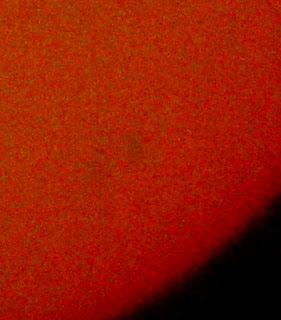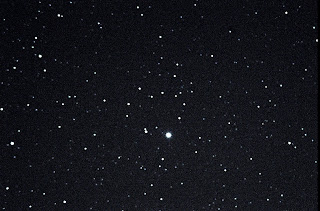January 29th 0045 GMT
Against all expectations, the sky was clear. I set my DSLR on ISO 800, 100mm focal length and 5 seconds exposure.
Unfortunately, the stacking did not work with any programs.
However, on further investigation, I discarded a few frames and stacked 56.
However, on further investigation, I discarded a few frames and stacked 56.
January 28th 1815 GMT
There was some cloud around but Venus and Mars were still quite close. I used the intervalometer to take 60 frames at 2 seconds, 70mm focal length and ISO 800.I then used the same settings to take the dark frames.
January 28th 0950 GMT
I bin scanned the Sun through thin cloud but did not see any sunspots.January 24th 1310 GMT
A lunchtime bin scan revealed a single large sunspot.
January 22nd 1820 GMT
It was just about dark, so I tried using another new piece of equipment. I took 25 frames of Venus with Mars at ISO 800, 2 seconds exposure and 70mm focal length. I repeated the same sequence for dark frames.
Immediately afterwards, I set it up pointing at the zenith with ISO 800, 30 seconds exposure and 18mm focal length. I was hoping for a sporadic meteor. I didn't get any meteors but I caught two parts of a satellite trail.
I composed the final zenith image from 39 frames.
January 22nd 1700 GMT
I decided to have a proper go at Venus. Visually, it appeared to be slightly smaller than a 50% phase. I tried the Bresser Electronic Eyepiece for the first time and the image was disco-dancing. I did some imaging runs more in hope than expectancy. Even turning the brightness down did not help!
The afocal images with 103x magnification did not look too good either but a quick look suggested that I could get an image from at least some of them. It was the best result.
January 22nd 1220 GMT
There was some haze around but a bin scan showed some new sunspot activity.
Straight afterwards, I did a hydrogen alpha shoot with my PST.
January 21st 1000 GMT
I bin scanned the Sun but could not see any sunspots.
I followed up with a hydrogen alpha shoot with my PST, I could see a couple of plages near tom where I had seen the filament the day before.
January 20th 2130 GMT
I took a few 30 second exposures of Orion with ISO 800 and 18mm. DSS did not work and Orion was left a but skewed.
January 20th 1440 GMT
I checked the Sun with my PST. Although it was quiet, there was a stand-out prominence that was visible in the images but not clear.
January 20th 1405 GMT
Despite the clear sky, my bin scan did not reveal any sunspots.
January 19th 2040 GMT
I took some 30 second exposures of the Polaris region at ISO 6400 and 30 seconds exposure. I also took some darks. Unfortunately, Deep Sky Stacker only accepted 2 light frames and used 8 darks. I finished off in GIMP.
January 19th 1810 GMT
I stopped on the way home to catch Venus and Mars and used a DSLR with the same settings as recent shots.
January 19th 1305 GMT
Although it was mostly cloudy, there were gaps and I was able to see sunspots for the first time for ages.
January 18th 2040 GMT
It finally cleared but I was quite busy, so I took a few zenith shots and some darks, ready to process. I used ISO 800 30 seconds exposure and 18mm focal length.
January 18th 0720 GMT
It was well into dawn but Jupiter was still visible. I took some quick shots of the Moon and Jupiter before setting off for work.
I caught the Moon using my normal method and was quite pleased with the (camera-only) result. There was too much shake in the shots with Venus.
January 15th 1305 GMT
On an otherwise cloudy day, I caught the Sun through a partial gap. However, I did not see any sunspots.January 14th 0935 GMT
The Sun was low but I managed to get a clear disc with signs of limb darkening through the thin cloud. There were no sunspots, though.
January 11th 1800 GMT
I took another shot of Venus and Mars at 70mm and 2 seconds exposure. Conditions were much worse than the previous shot and it took a lot of processing to remove the glare of Venus and catch some background stars.
January 5th 1805 GMT
There was some haze around, especially to the south and west. Venus seemed to be getting even closer to Mars. I kept the same camera focal length and settings as two days before, hoping to do a composite picture sometime later.
Finally, I could not resist a peek at the Pleiades (M45) and Hyades. They looked great and it was nice to see them again for the first time for what had seemed ages.
January 3rd 1750 GMT
With less than convincing weather forecast, I stopped off on the way home. I took some lunar shots with the DSLR at 300mm ISO 400 and 1/4000 second exposure.
Although the Moon was east of Mars, I could still get them and Venus in the same 70mm field of view.
January 2nd 1720 GMT
I took some shots of the Moon, Venus and Mars in the same 70mm field of view in my DSLR. The best result was with ISO 400 and 2 seconds exposure.January 2nd 1640 GMT
I took some full disc shots of the Moon with the Mak and DSLR. I used ISO 400 and 1/500 second exposure. I stacked 44 frames in Microsoft ICE and finished off with GIMP.
I reduced the exposure to 1/4000 second to snap Venus but I could not get a sharp focus. On the other hand, at least my photo showed the phase.
January 2nd 1030 GMT
The first action of the year was a solar hydrogen alpha shoot. I saw and captured the first prominence for ages.













































No comments:
Post a Comment